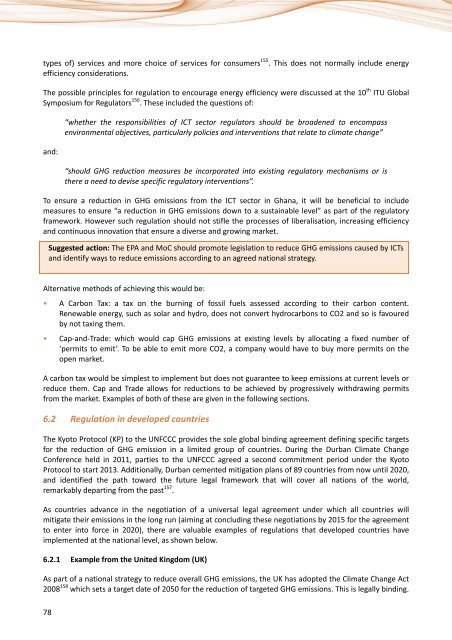Information and communication technologies (ICTs) and ... - ITU
Information and communication technologies (ICTs) and ... - ITU
Information and communication technologies (ICTs) and ... - ITU
You also want an ePaper? Increase the reach of your titles
YUMPU automatically turns print PDFs into web optimized ePapers that Google loves.
types of) services <strong>and</strong> more choice of services for consumers 155 . This does not normally include energy<br />
efficiency considerations.<br />
The possible principles for regulation to encourage energy efficiency were discussed at the 10 th <strong>ITU</strong> Global<br />
Symposium for Regulators 156 . These included the questions of:<br />
<strong>and</strong>:<br />
“whether the responsibilities of ICT sector regulators should be broadened to encompass<br />
environmental objectives, particularly policies <strong>and</strong> interventions that relate to climate change”<br />
“should GHG reduction measures be incorporated into existing regulatory mechanisms or is<br />
there a need to devise specific regulatory interventions”.<br />
To ensure a reduction in GHG emissions from the ICT sector in Ghana, it will be beneficial to include<br />
measures to ensure “a reduction in GHG emissions down to a sustainable level” as part of the regulatory<br />
framework. However such regulation should not stifle the processes of liberalisation, increasing efficiency<br />
<strong>and</strong> continuous innovation that ensure a diverse <strong>and</strong> growing market.<br />
Suggested action: The EPA <strong>and</strong> MoC should promote legislation to reduce GHG emissions caused by <strong>ICTs</strong><br />
<strong>and</strong> identify ways to reduce emissions according to an agreed national strategy.<br />
Alternative methods of achieving this would be:<br />
• A Carbon Tax: a tax on the burning of fossil fuels assessed according to their carbon content.<br />
Renewable energy, such as solar <strong>and</strong> hydro, does not convert hydrocarbons to CO2 <strong>and</strong> so is favoured<br />
by not taxing them.<br />
• Cap-<strong>and</strong>-Trade: which would cap GHG emissions at existing levels by allocating a fixed number of<br />
‘permits to emit’. To be able to emit more CO2, a company would have to buy more permits on the<br />
open market.<br />
A carbon tax would be simplest to implement but does not guarantee to keep emissions at current levels or<br />
reduce them. Cap <strong>and</strong> Trade allows for reductions to be achieved by progressively withdrawing permits<br />
from the market. Examples of both of these are given in the following sections.<br />
6.2 Regulation in developed countries<br />
The Kyoto Protocol (KP) to the UNFCCC provides the sole global binding agreement defining specific targets<br />
for the reduction of GHG emission in a limited group of countries. During the Durban Climate Change<br />
Conference held in 2011, parties to the UNFCCC agreed a second commitment period under the Kyoto<br />
Protocol to start 2013. Additionally, Durban cemented mitigation plans of 89 countries from now until 2020,<br />
<strong>and</strong> identified the path toward the future legal framework that will cover all nations of the world,<br />
remarkably departing from the past 157 .<br />
As countries advance in the negotiation of a universal legal agreement under which all countries will<br />
mitigate their emissions in the long run (aiming at concluding these negotiations by 2015 for the agreement<br />
to enter into force in 2020), there are valuable examples of regulations that developed countries have<br />
implemented at the national level, as shown below.<br />
6.2.1 Example from the United Kingdom (UK)<br />
As part of a national strategy to reduce overall GHG emissions, the UK has adopted the Climate Change Act<br />
2008 158 which sets a target date of 2050 for the reduction of targeted GHG emissions. This is legally binding.<br />
78

















